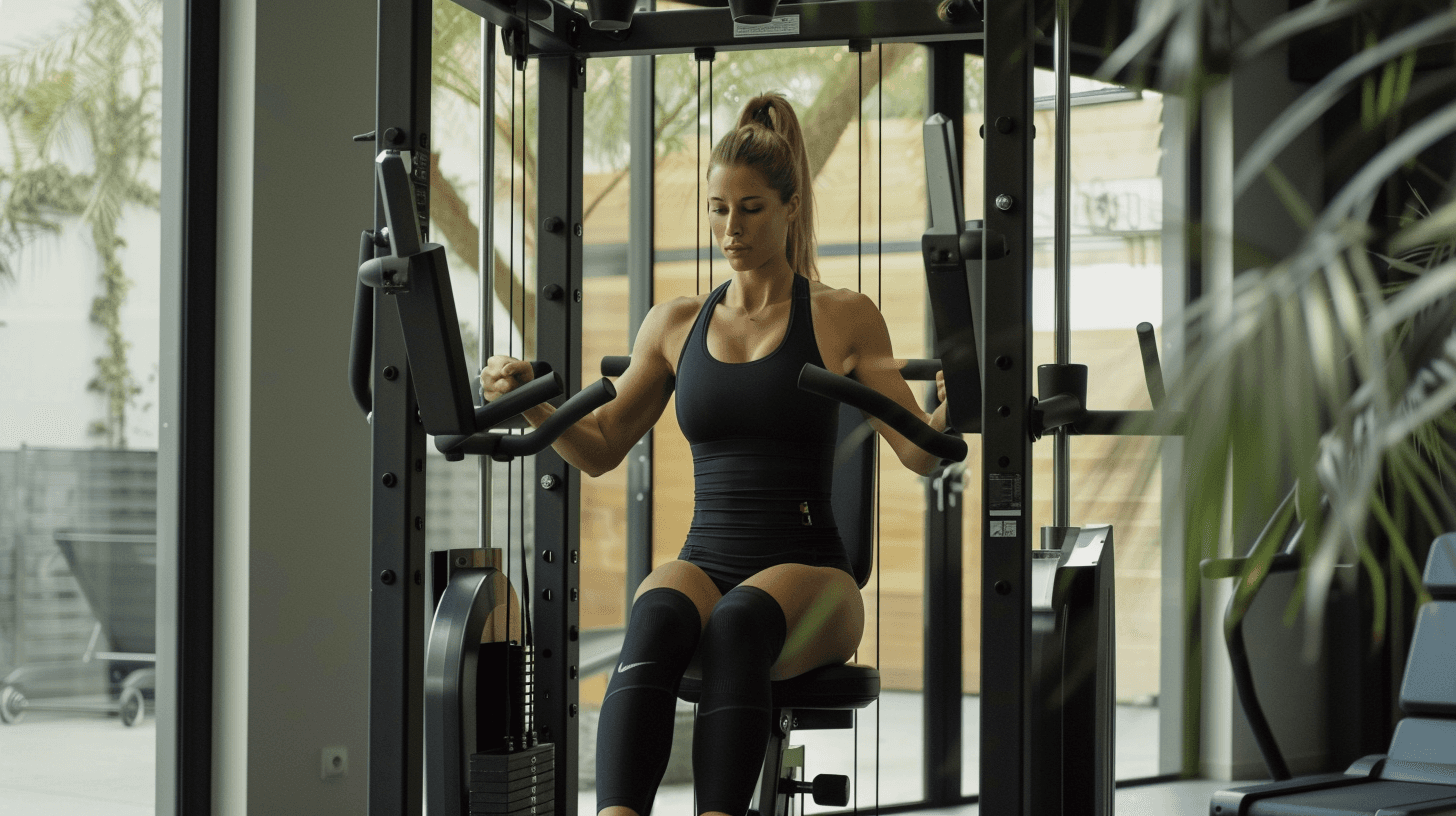Workout
Effective Postpartum Workout Plan for New Mothers
Discover a postpartum workout plan to help new mothers regain strength and fitness. Get detailed exercises, tips, and FAQs for optimal recovery.
Jun 28, 2024



Introduction
Recovering from childbirth and getting back into a fitness routine can be challenging for new mothers. A well-structured postpartum workout plan can help you regain strength, improve energy levels, and boost overall well-being. This guide provides a comprehensive postpartum workout plan designed to accommodate the unique needs of new mothers. Whether you’re a fitness enthusiast, a gym-goer looking for custom workout plans, or a busy professional serious about your health, this plan will help you navigate your fitness journey post-pregnancy. Read on to discover the benefits of postpartum exercise, a detailed workout plan, and tips for success.
Introduction
Recovering from childbirth and getting back into a fitness routine can be challenging for new mothers. A well-structured postpartum workout plan can help you regain strength, improve energy levels, and boost overall well-being. This guide provides a comprehensive postpartum workout plan designed to accommodate the unique needs of new mothers. Whether you’re a fitness enthusiast, a gym-goer looking for custom workout plans, or a busy professional serious about your health, this plan will help you navigate your fitness journey post-pregnancy. Read on to discover the benefits of postpartum exercise, a detailed workout plan, and tips for success.
Benefits of a Postpartum Workout Plan

Improved Physical Recovery
Exercise can help speed up recovery after childbirth by strengthening the muscles affected during pregnancy and delivery.
Increased Energy Levels
Regular physical activity boosts energy levels, helping you manage the demands of caring for a newborn.
Enhanced Mental Health
Postpartum exercise can reduce stress, anxiety, and symptoms of postpartum depression, improving overall mental health.
Weight Management
A structured workout plan aids in gradual and healthy weight loss, helping you return to your pre-pregnancy weight.
Strengthened Core and Pelvic Floor
Specific postpartum exercises target the core and pelvic floor muscles, which are crucial for overall stability and reducing postpartum complications.
Understanding Postpartum Fitness

When to Start
Consult with your healthcare provider before starting any exercise program, especially if you had a C-section or experienced complications during delivery. Generally, it’s safe to start light exercises 6-8 weeks postpartum.
Key Focus Areas
Pelvic Floor Exercises: Strengthen the muscles weakened during pregnancy and childbirth.
Core Strengthening: Target the abdominal muscles to improve core stability.
Cardio: Boost cardiovascular health and aid in weight loss.
Strength Training: Regain muscle strength and tone.
Postpartum Workout Plan
Week 1-2: Gentle Movements
Day 1
Pelvic Floor Exercises (Kegels): 3 sets of 10 reps
Walking: 15-20 minutes at a comfortable pace
Day 2
Pelvic Tilts: 3 sets of 10 reps
Bridges: 3 sets of 10 reps
Day 3
Rest Day
Day 4
Walking: 15-20 minutes
Seated Marches: 3 sets of 10 reps per leg
Day 5
Pelvic Floor Exercises (Kegels): 3 sets of 10 reps
Cat-Cow Stretches: 3 sets of 10 reps
Day 6
Rest Day
Day 7
Walking: 15-20 minutes
Week 3-4: Building Strength
Day 1
Pelvic Floor Exercises (Kegels): 3 sets of 15 reps
Walking: 20-25 minutes
Bodyweight Squats: 3 sets of 10 reps
Day 2
Modified Plank (Knees Down): 3 sets of 10 seconds
Bridges: 3 sets of 15 reps
Bicep Curls with Light Weights: 3 sets of 10 reps
Day 3
Rest Day
Day 4
Walking: 20-25 minutes
Pelvic Tilts: 3 sets of 15 reps
Tricep Dips: 3 sets of 10 reps
Day 5
Pelvic Floor Exercises (Kegels): 3 sets of 15 reps
Seated Marches: 3 sets of 15 reps per leg
Cat-Cow Stretches: 3 sets of 15 reps
Day 6
Rest Day
Day 7
Walking: 20-25 minutes
Week 5-6: Increasing Intensity
Day 1
Pelvic Floor Exercises (Kegels): 3 sets of 20 reps
Walking: 25-30 minutes
Lunges: 3 sets of 10 reps per leg
Day 2
Plank (Full or Modified): 3 sets of 20 seconds
Bridges with Marches: 3 sets of 10 reps per leg
Dumbbell Rows: 3 sets of 10 reps per arm
Day 3
Rest Day
Day 4
Walking: 25-30 minutes
Bodyweight Squats: 3 sets of 15 reps
Shoulder Press with Light Weights: 3 sets of 10 reps
Day 5
Pelvic Floor Exercises (Kegels): 3 sets of 20 reps
Pelvic Tilts: 3 sets of 20 reps
Tricep Dips: 3 sets of 15 reps
Day 6
Rest Day
Day 7
Walking: 25-30 minutes
Tips for Success on a Postpartum Workout Plan
Listen to Your Body
Pay attention to your body’s signals and avoid pushing yourself too hard. Rest when needed and modify exercises if necessary.
Stay Hydrated
Drink plenty of water throughout the day to stay hydrated, especially if you’re breastfeeding.
Maintain a Balanced Diet
Support your workouts with a balanced diet rich in protein, fruits, vegetables, and whole grains.
Prioritize Sleep
Get adequate rest to aid recovery and maintain energy levels.
Seek Support
Join a postpartum fitness group or find a workout buddy to stay motivated and accountable.
Benefits of a Postpartum Workout Plan

Improved Physical Recovery
Exercise can help speed up recovery after childbirth by strengthening the muscles affected during pregnancy and delivery.
Increased Energy Levels
Regular physical activity boosts energy levels, helping you manage the demands of caring for a newborn.
Enhanced Mental Health
Postpartum exercise can reduce stress, anxiety, and symptoms of postpartum depression, improving overall mental health.
Weight Management
A structured workout plan aids in gradual and healthy weight loss, helping you return to your pre-pregnancy weight.
Strengthened Core and Pelvic Floor
Specific postpartum exercises target the core and pelvic floor muscles, which are crucial for overall stability and reducing postpartum complications.
Understanding Postpartum Fitness

When to Start
Consult with your healthcare provider before starting any exercise program, especially if you had a C-section or experienced complications during delivery. Generally, it’s safe to start light exercises 6-8 weeks postpartum.
Key Focus Areas
Pelvic Floor Exercises: Strengthen the muscles weakened during pregnancy and childbirth.
Core Strengthening: Target the abdominal muscles to improve core stability.
Cardio: Boost cardiovascular health and aid in weight loss.
Strength Training: Regain muscle strength and tone.
Postpartum Workout Plan
Week 1-2: Gentle Movements
Day 1
Pelvic Floor Exercises (Kegels): 3 sets of 10 reps
Walking: 15-20 minutes at a comfortable pace
Day 2
Pelvic Tilts: 3 sets of 10 reps
Bridges: 3 sets of 10 reps
Day 3
Rest Day
Day 4
Walking: 15-20 minutes
Seated Marches: 3 sets of 10 reps per leg
Day 5
Pelvic Floor Exercises (Kegels): 3 sets of 10 reps
Cat-Cow Stretches: 3 sets of 10 reps
Day 6
Rest Day
Day 7
Walking: 15-20 minutes
Week 3-4: Building Strength
Day 1
Pelvic Floor Exercises (Kegels): 3 sets of 15 reps
Walking: 20-25 minutes
Bodyweight Squats: 3 sets of 10 reps
Day 2
Modified Plank (Knees Down): 3 sets of 10 seconds
Bridges: 3 sets of 15 reps
Bicep Curls with Light Weights: 3 sets of 10 reps
Day 3
Rest Day
Day 4
Walking: 20-25 minutes
Pelvic Tilts: 3 sets of 15 reps
Tricep Dips: 3 sets of 10 reps
Day 5
Pelvic Floor Exercises (Kegels): 3 sets of 15 reps
Seated Marches: 3 sets of 15 reps per leg
Cat-Cow Stretches: 3 sets of 15 reps
Day 6
Rest Day
Day 7
Walking: 20-25 minutes
Week 5-6: Increasing Intensity
Day 1
Pelvic Floor Exercises (Kegels): 3 sets of 20 reps
Walking: 25-30 minutes
Lunges: 3 sets of 10 reps per leg
Day 2
Plank (Full or Modified): 3 sets of 20 seconds
Bridges with Marches: 3 sets of 10 reps per leg
Dumbbell Rows: 3 sets of 10 reps per arm
Day 3
Rest Day
Day 4
Walking: 25-30 minutes
Bodyweight Squats: 3 sets of 15 reps
Shoulder Press with Light Weights: 3 sets of 10 reps
Day 5
Pelvic Floor Exercises (Kegels): 3 sets of 20 reps
Pelvic Tilts: 3 sets of 20 reps
Tricep Dips: 3 sets of 15 reps
Day 6
Rest Day
Day 7
Walking: 25-30 minutes
Tips for Success on a Postpartum Workout Plan
Listen to Your Body
Pay attention to your body’s signals and avoid pushing yourself too hard. Rest when needed and modify exercises if necessary.
Stay Hydrated
Drink plenty of water throughout the day to stay hydrated, especially if you’re breastfeeding.
Maintain a Balanced Diet
Support your workouts with a balanced diet rich in protein, fruits, vegetables, and whole grains.
Prioritize Sleep
Get adequate rest to aid recovery and maintain energy levels.
Seek Support
Join a postpartum fitness group or find a workout buddy to stay motivated and accountable.

Your all-in-one fitness plan is just one click away
Try it free for 7 days. Cancel anytime.

Your all-in-one fitness plan is just one click away
Try it free for 7 days. Cancel anytime.

Your all-in-one fitness plan is just one click away
Try it free for 7 days. Cancel anytime.
Conclusion
A well-structured postpartum workout plan is essential for regaining strength, improving energy levels, and enhancing overall well-being after childbirth. By focusing on pelvic floor exercises, core strengthening, cardio, and strength training, you can achieve a balanced and effective fitness routine. Whether you’re a fitness enthusiast, a gym-goer, or a busy professional, this plan provides a comprehensive approach to postpartum fitness.
Explore Fit Senpai for customized workout and meal plans tailored to your needs, helping you stay on track and achieve your health goals. Embrace your postpartum journey with confidence and discover the benefits of a structured workout plan.
Conclusion
A well-structured postpartum workout plan is essential for regaining strength, improving energy levels, and enhancing overall well-being after childbirth. By focusing on pelvic floor exercises, core strengthening, cardio, and strength training, you can achieve a balanced and effective fitness routine. Whether you’re a fitness enthusiast, a gym-goer, or a busy professional, this plan provides a comprehensive approach to postpartum fitness.
Explore Fit Senpai for customized workout and meal plans tailored to your needs, helping you stay on track and achieve your health goals. Embrace your postpartum journey with confidence and discover the benefits of a structured workout plan.
Conclusion
A well-structured postpartum workout plan is essential for regaining strength, improving energy levels, and enhancing overall well-being after childbirth. By focusing on pelvic floor exercises, core strengthening, cardio, and strength training, you can achieve a balanced and effective fitness routine. Whether you’re a fitness enthusiast, a gym-goer, or a busy professional, this plan provides a comprehensive approach to postpartum fitness.
Explore Fit Senpai for customized workout and meal plans tailored to your needs, helping you stay on track and achieve your health goals. Embrace your postpartum journey with confidence and discover the benefits of a structured workout plan.
FAQ
When can I start a postpartum workout plan?
Consult with your healthcare provider before starting any exercise program. Generally, it’s safe to start light exercises 6-8 weeks postpartum.
What are the benefits of postpartum exercise?
Benefits include improved physical recovery, increased energy levels, enhanced mental health, weight management, and strengthened core and pelvic floor muscles.
What types of exercises are included in a postpartum workout plan?
A postpartum workout plan includes pelvic floor exercises, core strengthening, cardio, and strength training exercises.
How often should I exercise postpartum?
Aim for at least 3-4 days of exercise per week, gradually increasing intensity as your body recovers.
Can I do high-intensity workouts postpartum?
Start with gentle movements and gradually increase intensity. Consult with your healthcare provider before attempting high-intensity workouts.
How can I stay motivated to exercise postpartum?
Join a postpartum fitness group, find a workout buddy, or set specific fitness goals to stay motivated.
What should I eat to support my postpartum workouts?
Maintain a balanced diet rich in protein, fruits, vegetables, and whole grains to support your workouts and overall health.
How do I know if I’m overdoing it with postpartum exercise?
Pay attention to your body’s signals. If you experience pain, excessive fatigue, or unusual symptoms, rest and consult with your healthcare provider.
Are there specific exercises to avoid postpartum?
Avoid high-impact exercises and heavy lifting in the initial postpartum period. Focus on gentle movements and gradually progress.
How can Fit Senpai help with postpartum fitness?
Fit Senpai offers customized workout and meal plans tailored to your specific needs, helping you stay on track and achieve your health goals.
FAQ
When can I start a postpartum workout plan?
Consult with your healthcare provider before starting any exercise program. Generally, it’s safe to start light exercises 6-8 weeks postpartum.
What are the benefits of postpartum exercise?
Benefits include improved physical recovery, increased energy levels, enhanced mental health, weight management, and strengthened core and pelvic floor muscles.
What types of exercises are included in a postpartum workout plan?
A postpartum workout plan includes pelvic floor exercises, core strengthening, cardio, and strength training exercises.
How often should I exercise postpartum?
Aim for at least 3-4 days of exercise per week, gradually increasing intensity as your body recovers.
Can I do high-intensity workouts postpartum?
Start with gentle movements and gradually increase intensity. Consult with your healthcare provider before attempting high-intensity workouts.
How can I stay motivated to exercise postpartum?
Join a postpartum fitness group, find a workout buddy, or set specific fitness goals to stay motivated.
What should I eat to support my postpartum workouts?
Maintain a balanced diet rich in protein, fruits, vegetables, and whole grains to support your workouts and overall health.
How do I know if I’m overdoing it with postpartum exercise?
Pay attention to your body’s signals. If you experience pain, excessive fatigue, or unusual symptoms, rest and consult with your healthcare provider.
Are there specific exercises to avoid postpartum?
Avoid high-impact exercises and heavy lifting in the initial postpartum period. Focus on gentle movements and gradually progress.
How can Fit Senpai help with postpartum fitness?
Fit Senpai offers customized workout and meal plans tailored to your specific needs, helping you stay on track and achieve your health goals.
FAQ
When can I start a postpartum workout plan?
Consult with your healthcare provider before starting any exercise program. Generally, it’s safe to start light exercises 6-8 weeks postpartum.
What are the benefits of postpartum exercise?
Benefits include improved physical recovery, increased energy levels, enhanced mental health, weight management, and strengthened core and pelvic floor muscles.
What types of exercises are included in a postpartum workout plan?
A postpartum workout plan includes pelvic floor exercises, core strengthening, cardio, and strength training exercises.
How often should I exercise postpartum?
Aim for at least 3-4 days of exercise per week, gradually increasing intensity as your body recovers.
Can I do high-intensity workouts postpartum?
Start with gentle movements and gradually increase intensity. Consult with your healthcare provider before attempting high-intensity workouts.
How can I stay motivated to exercise postpartum?
Join a postpartum fitness group, find a workout buddy, or set specific fitness goals to stay motivated.
What should I eat to support my postpartum workouts?
Maintain a balanced diet rich in protein, fruits, vegetables, and whole grains to support your workouts and overall health.
How do I know if I’m overdoing it with postpartum exercise?
Pay attention to your body’s signals. If you experience pain, excessive fatigue, or unusual symptoms, rest and consult with your healthcare provider.
Are there specific exercises to avoid postpartum?
Avoid high-impact exercises and heavy lifting in the initial postpartum period. Focus on gentle movements and gradually progress.
How can Fit Senpai help with postpartum fitness?
Fit Senpai offers customized workout and meal plans tailored to your specific needs, helping you stay on track and achieve your health goals.
You may also want to read this:
You may also want to read this:



3-Day Split Workout - The Complete Guide (2025)
Get the most out of your workouts with this 3-day split plan. Ideal for all levels, it balances training, recovery, and results to build muscle and strength.



7-Day Gym Workout Plan: Achieve Your Fitness Goals
Discover a 7-day gym workout plan targeting all major muscles. Includes daily workouts, nutrition tips, and recovery strategies. Start Fit Senpai today.



Achieve Muscle Balance with an Upper and Lower Split Program
Maximize gym sessions with an upper-lower split for strength and balance. Get a custom workout plan to achieve your fitness goals!
Your all-in-one fitness plan is just one click away
Try it free for 7 days. Cancel anytime.
Your all-in-one fitness plan is just one click away
Try it free for 7 days. Cancel anytime.
Your all-in-one fitness plan is just one click away
Try it free for 7 days. Cancel anytime.




